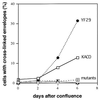Inability of keratinocytes lacking their specific transglutaminase to form cross-linked envelopes: absence of envelopes as a simple diagnostic test for lamellar ichthyosis
- PMID: 9435253
- PMCID: PMC18481
- DOI: 10.1073/pnas.95.2.687
Inability of keratinocytes lacking their specific transglutaminase to form cross-linked envelopes: absence of envelopes as a simple diagnostic test for lamellar ichthyosis
Abstract
Epidermal keratinocytes, late in their terminal differentiation, form cross-linked envelopes resistant to ionic detergent and reducing agent. Because the cross-linking process is catalyzed by the keratinocyte transglutaminase, the absence of active transglutaminase should result in failure of the keratinocyte to form a cross-linked envelope. Three keratinocyte strains bearing mutations in the keratinocyte transglutaminase were examined: two contained no detectable transglutaminase mRNA and none contained active enzyme. All three were unable to form cross-linked envelopes, either spontaneously in stratified cultures or upon induction with Ca2+. Although stratum corneum of normal humans and scales from patients with different ichthyotic diseases contain cross-linked envelopes, those from patients with transglutaminase-negative lamellar ichthyosis do not. Therefore, the disease due to the absence of transglutaminase may be readily distinguished from other ichthyotic disease by a simple test for cross-linked envelopes.
Figures




References
Publication types
MeSH terms
Substances
LinkOut - more resources
Full Text Sources
Miscellaneous

